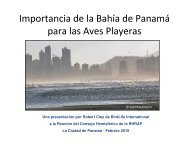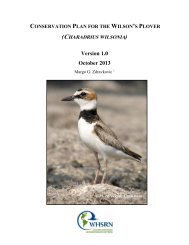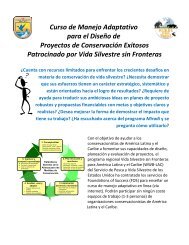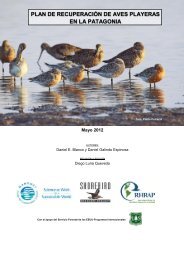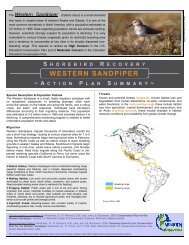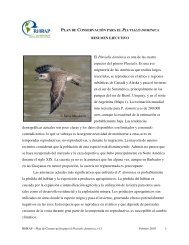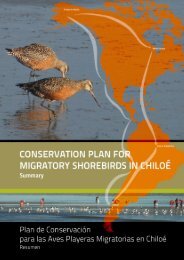Sanderling Plan - Western Hemisphere Shorebird Reserve Network
Sanderling Plan - Western Hemisphere Shorebird Reserve Network
Sanderling Plan - Western Hemisphere Shorebird Reserve Network
You also want an ePaper? Increase the reach of your titles
YUMPU automatically turns print PDFs into web optimized ePapers that Google loves.
<strong>Sanderling</strong> populations on managed lands. Specific management goals will vary by region and<br />
by site, but should contribute to the overall objective of increasing <strong>Sanderling</strong> populations.<br />
Range-wide monitoring efforts for <strong>Sanderling</strong>s need to be coordinated to better inform<br />
conservation strategies and measure success or failure of conservation actions.<br />
Priorities for <strong>Sanderling</strong> conservation include identifying important habitats for foraging<br />
and roosting, protecting and (where necessary) managing food resources, reducing human<br />
disturbance, and reducing contaminants. General management objectives should include training<br />
land managers to identify shorebirds, manage habitat for <strong>Sanderling</strong>s, and minimize or prevent<br />
disturbance; and coordinating management among public lands (e.g., impoundments among<br />
states/refuges).<br />
Areas with <strong>Sanderling</strong> habitat should be prioritized for conservation within each flyway,<br />
region, and state. Disturbance should be reduced and managed through landowner outreach,<br />
visitor management, regulations, and area restrictions/closures (for recreational disturbance such<br />
as Personal WaterCraft and ATV users, beachgoers, dogs), and new regulations should be<br />
created where necessary.<br />
In areas where oil spills are likely (for example, North Atlantic Region), improved oil<br />
spill response is needed—and is attainable by conducting planning and simulations, monitoring<br />
and quantifying habitat and food resources prior to spill (as preparation for quantifying the direct<br />
and indirect effects of spills), and conducting post-spill surveys to accurately quantify spill<br />
damages (Clark and Niles 2000).<br />
Other types of contaminants should be reduced as well. In the case of dredged materials,<br />
improved dredging practices that address placement and quality of dredged material is needed<br />
(Clark and Niles 2000). In addition, the reduction of agricultural chemicals throughout the range<br />
would potentially improve the long-term viability of this species and many others.<br />
And finally, structural modifications that are likely to be put into place as beaches erode<br />
or as sea level rises need to be considered in terms of their potential impact on the <strong>Sanderling</strong><br />
and other coastal species (e.g., beach re-nourishment projects).<br />
Region-specific<br />
Regional objectives and priorities for shorebirds are outlined in Regional <strong>Shorebird</strong><br />
Conservation <strong>Plan</strong>s and Joint Venture <strong>Plan</strong>s. Regional <strong>Plan</strong>s are available for Alaska, Northern<br />
WHSRN – <strong>Sanderling</strong> Conservation <strong>Plan</strong>, February 2010, v1.1 55




